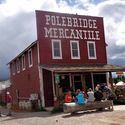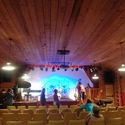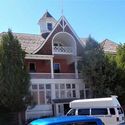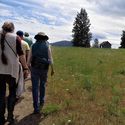Road trip to Montana Preservation Alliance's 2018 "Roadshow" in the Flathead
September 19, 2018
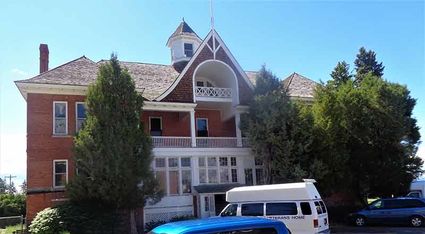
Old Main, pictured here, was once the administration and dormitory for the Soldiers' Home in Columbia Falls. Built in the 1890's the facility closed in 1970. Attempts to raise the required $1.5 million to preserve the 147 acre site of the Soldiers' Home Historic District have so far proven unsuccessful. Old Main is an example of a large number of historic buildings that will likely be lost for lack of funds to preserve them.
Reporter's note: In our efforts to do Montana-based road trips, in early June my wife and I attended a four-day "Roadshow" put together by the Montana Preservation Alliance (MPA). The MPA is a non-profit that works to preserve Montana's historic buildings and culturally significant places by helping locals find funding sources and know how. Readers may recall part of the statewide Big Sky Schoolhouse Survey was completed in Blaine County in 2015. That work was part of an MPA project to gather data about one room schools throughout Montana.
Each biennial Roadshow is set in a different region of the state and this year's show was in the Flathead area. The event brings together experts to talk about and show a region's history, heritage and culture. About 80 participants spent four days in the Flathead learning about homesteads and farms, tribal heritages, midcentury industrial architecture, the role of the railroad in the development of the area and recreation history in the national forest and park along the Flathead River.
The purpose of this year's Roadshow was to "provide participants with a well-rounded look at the places that define the Flathead and Glacier areas and their people." Here's some of what we learned about some special places we toured during our visit to the western part of "the last best place."
Boat trip to and hike around Wild Horse Island
Wild Horse Island is a 2100 acre island in Flathead Lake that is one of five units that make up Flathead State Park. Accessible only by boat, the island is managed by Montana's Fish, Wildlife and Parks (FWP) with a few pockets of private land and cabins sold off before the state acquired the island. About 20,000 guests visit the island each year and outfitters at Big Arm, a nearby community, provide boat trips to the island.

Legend has it that the Kootenai, who first inhabited the area, may have used the island as a corral for their horses to protect them from marauding tribes. There are five wild mares that still live on the island. There is a well-established herd of mountain sheep first introduced many years ago. The beneficial conditions for mountain sheep have produced a Boone and Crockett record ram scored at 216+ points. Much of the island is "Palouse prairie-like," a diminishing native prairie, and the numbers of big game and horses are limited to preserve the remaining unique prairie.
In 1910 the island was opened to homesteading and 30,000 people signed up, eight of whom proved up a claim. From 1915 onward single owners controlled the entire island. The harsh winters and lack of water up on the island doomed most attempts for long term settlement, agricultural enterprises or efforts at recreational businesses. The state of Montana acquired the island in 1978.
A trip to the North Fork area: "Most intense winters in the lower 48 states"
We made the 40 mile trip north along the north fork of the Flathead River by bus. The road, gravel after only a few miles, makes its way to Polebridge. Near there is a public entrance to Glacier National Park and the road ends, eventually, at the Canadian border. North Fork describes a general area that is the western edge of Glacier Park to the Canadian border.
Big Creek Ranger Station is a 1920-era Forest Service ranger station that served as a CCC camp in the 1930's and is now, since 1988, the summer home of Glacier Institute. The Institute provides outdoor learning and adventure programs for children and adults. A Forest Service official said, "The Institute uses the facility and maintains it. We don't have a budget to preserve it and an important part of the North Fork would be lost without the Institute being on site to keep things up." (you can learn about the programs of the Institute at http://www.glacierinsutute.org).
The rest of the tour focused on Polebridge and its surroundings. Polebridge took its name from a turn of the century river crossing, originally made of poles. When Glacier Park was created in 1910 most of the homesteaders who were in the area of the park moved west across the Flathead River and resettled around the Polebridge area.
The building housing the current Polebridge Mercantile was built in 1914. While still offering many items to locals and folks headed into the forest, it's also become a popular tourist stop in the summer and its bakery has quite a reputation as far south as Columbia Falls. About 10 people live year round in Polebridge and the town is still "off the grid" as far as utilities.
Polebridge is at the center of one of several debates in the area about whether to improve roads to certain areas to allow more visitors or keep areas less accessible and limit development. Over the years many original trails were improved to roads for access in the national forests, national parks and surrounding areas. Now problems with congestion, overuse and "loving our parks to death" as one speaker told, are now resulting in attempts to stop improving and even close roads to limit vehicle access. Visitors' desires to get off the beaten path and others desire to protect the wilderness give rise to a lot of conflict about national forest and park use policy.
Highlights of two tours in the Flathead Valley
On two occasions we chose to do tours that focused on structures and places in the Flathead Valley proper. We started one of those tours with a stop at the La Salle Grange Theatre. The National Grange was formed 150+ years ago as an organization to help farmers learn modern farming practices. The La Salle Grande, just outside Kalispell, was built in the 1930's and fell into disrepair. Then a transplanted couple from Nashville, Tennessee fell in love with the place and repurposed it as a 75-seat performance theatre and recording studio. What is billed as a "gift shop in the basement" is actually a collection of vintage and antique furniture and décor and well worth a stop just to see what Jack and Catherine Stephens have collected. Find the theatre info online at: http://www.angeltheater.com.
While in Kalispell we stopped to see the Bruyer Granary, a 1909 grain handling/storage facility once on a private farm. The Norwegian homesteader hand milled the lumber and built the granary himself. The 11,000 bushel granary was built so a horse drawn wagon load of grain could enter one side of the building and, once the team was unhitched, a hand crank system lifted the front of the wagon to empty the grain into a receptacle in the floor. A bucket elevator lifted the grain to the 'headhouse' (cupola on top) and the gravity fed the grain into the desired storage areas. The horses were rehitched and the empty wagon went out the other side of the granary. After falling into a state of disrepair, the family of the original settler spent $90,000 to restore the facility and donated the building and land to the city of Kalispell.
'Road Show' - Flathead
Another unusual farm building, also built by a Norwegian homesteader in the valley, is the Wiley Homestead Water Tank. When an old schoolhouse was rebuilt as a house in 1907, the homesteader built the heated water tower to provide water to only the kitchen of the house. The tank was heated in the winter to prevent freezing. Christian Hvila (anglicized to Wiley) worked winters for many years in the hard rock mines in Butte to help support his family back on the homestead on the Flathead River.
A more recent significant set of structures in the Columbia Falls area is the Columbia Falls Aluminum Company. Built in the area mainly to take advantage of cheap hydro produced electricity, the plant opened in 1955. At one time it employed 1,000 workers. The plant went through major upgrades, costing millions of dollars, then closed after being purchased by an international company that deals in many metals. In 2015 the dismantling the of the facility began, including the 40 acres of pot line buildings said to be the largest structure in Montana. Steve Wright, former plant superintendent and the last employee of the aluminum company, said, "There's still a market for aluminum, but producers are moving to countries with cheaper power and labor." There are still significant pollution problems from some of the areas where waste was disposed, resulting in the site being designated as a superfund site.
An especially good example of the conflict between the desire to preserve historic buildings and the lack of resources to do so was the difficulty locals have had trying to find funding to preserve the nine buildings that make up the Soldiers' Home Historic District adjacent to the current Montana Veterans' Home Columbia Falls. In a last minute attempt to save Old Main, the original 1896 combined administrative and living space, former U.S. Senator Conrad Burns helped a preservation group get a $300,000 grant that allowed for a new roof to stabilize the building. Preservationists believe it would take about $1.5 million to restore the building and have very little prospect of finding funds for the project.
Some observations from time spent in the Flathead and near Glacier Park
Like everywhere in the state and, likely, the nation, there are thousands of preservation projects that would help preserve important parts of our culture and history. We see the problem with old barns even in our part of the country, too costly to maintain and fall in. The sad truth is there are few financial resources to do preservation work and many of our historical landmarks will be lost to deterioration and neglect.
Another trend, discussed earlier, is the over use and crowding of parts of our national parks, like Going-to-the-Sun Road. A lot of people feel the iconic road will have to have limited access, perhaps only by bus, just for safety reasons.
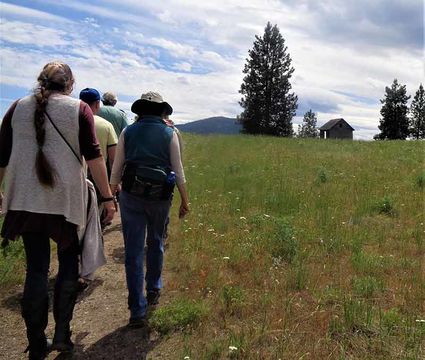
Participants in the Montana Preservation Alliance's 2018 Roadshow make their way up a hill on Wild Horse Island in Flathead Lake to view the remains of one of eight homesteads that were proved up on the island. The state of Montana took possession of the 2100 acre island in 1978 and the island is one part of Flathead State Park.
Visitor surveys have shown that less than 1% of visitors go more than 100 feet from a roadway in Glacier Park, and for most that is probably an adequate encounter with the 'wilderness.' Yet there is mounting demand to open more wilderness so more people can have their "wilderness fix" and to build more roads to once inaccessible locales. Providing access and still preserve the wilderness is not an easy challenge to meet and not likely a problem that will be solved to everyone's liking.


